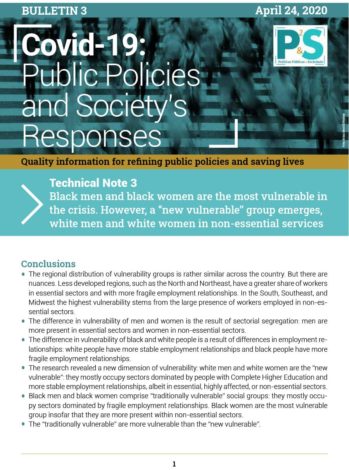Conclusions
- The regional distribution of vulnerability groups is rather similar across the country. But there are nuances. Less developed regions, such as the North and Northeast, have a greater share of workers in essential sectors and with more fragile employment relationships. In the South, Southeast, and Midwest the highest vulnerability stems from the large presence of workers employed in non-essential sectors.
- The difference in vulnerability of men and women is the result of sectorial segregation: men are more present in essential sectors and women in non-essential sectors.
- The difference in vulnerability of black and white people is a result of differences in employment relationships: white people have more stable employment relationships and black people have more fragile employment relationships.
- The research revealed a new dimension of vulnerability: white men and white women are the “new vulnerable”: they mostly occupy sectors dominated by people with Complete Higher Education and more stable employment relationships, albeit in essential, highly affected, or non-essential sectors.
- Black men and black women comprise “traditionally vulnerable” social groups: they mostly occupy sectors dominated by fragile employment relationships. Black women are the most vulnerable group insofar that they are more present within non-essential sectors.
- The “traditionally vulnerable” are more vulnerable than the “new vulnerable”.
Work group responsible
Coordination: Ian Prates e Rogério Jerônimo Barbosa
Researcher
- Jefferson Leal


